|
 |
keeping you - |
AWARE OF THE PAST
ABREAST OF THE PRESENT
ALERT ABOUT THE FUTURE |
|
 |
| |
| MALE FIGURINES |
| |
|
| |
|
Male head, Mohenjo-daro
Male head probably broken from a seated sculpture. Finely braided or wavy combed hair tied into a double bun on the back of the head and a plain fillet or headband with two hanging ribbons falling down the back
The upper lip is shaved and a closely cropped and combed beard lines the pronounced lower jaw. The stylized almond shaped eyes are framed by long eyebrows. The wide mouth is very similar to that on the "Priest-King" sculpture. Stylized ears are made of a double curve with a central knob.
Material: sandstone
Dimensions: 13.5 cm height
Mohenjo-daro, DK-B 1057
Mohenjo-daro Museum, MM 431
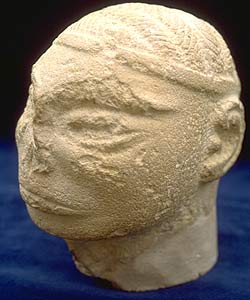 
|
|
|
| |
|
"Priest King", Mohenjo-daro
Seated male sculpture, or "Priest King" from Mohenjo-daro. Fillet or ribbon headband with circular inlay ornament on the forehead and similar but smaller ornament on the right upper arm. The two ends of the fillet fall along the back and though the hair is carefully combed towards the back of the head, no bun is present. The flat back of the head may have held a separately carved bun as is traditional on the other seated figures, or it could have held a more elaborate horn and plumed headdress.
Two holes beneath the highly stylized ears suggest that a necklace or other head ornament was attached to the sculpture. The left shoulder is covered with a cloak decorated with trefoil, double circle and single circle designs that were originally filled with red pigment. Drill holes in the center of each circle indicate they were made with a specialized drill and then touched up with a chisel. Eyes are deeply incised and may have held inlay. The upper lip is shaved and a short combed beard frames the face. The large crack in the face is the result of weathering or it may be due to original firing of this object.
Material: white, low fired steatite
Dimensions: 17.5 cm height, 11 cm width
Mohenjo-daro, DK 1909
National Museum, Karachi, 50.852
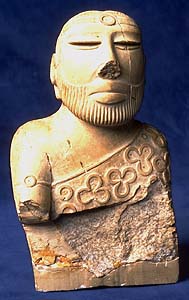 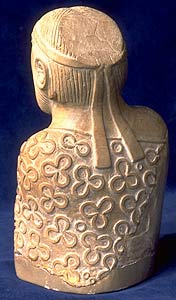 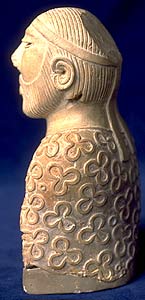
|
|
|
| |
|
Sculpture
Seated male sculpture with shell inlay still remaining in one eye. The braided or combed hair lays back straight and a plain fillet or ribbon encircles the head and falls down the back of the neck. Two strands of a ribbon or braided hair hang over the shoulder. The stylized ear is a simple cup shape with a hole in the center. The upper lip is shaved and a short combed beard covers the lower jaw. The forward projecting head and large lips may reflect a specific personality or may be due to the particular style of carving.
Slight traces of what may have been a cloak are visible on the back but the legs clearly visible and not totally covered with a garment as in other sculptures. The left arm is resting on top of the lowered left knee, while the right hand is resting on the upraised right leg. This sitting pattern is opposite of that seen on other sculptures.
Material: limestone
Mohenjo-daro Museum
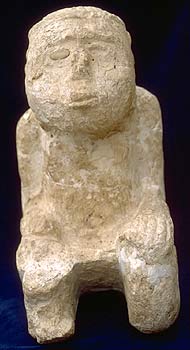
|
|
Male Figurine from Harappa
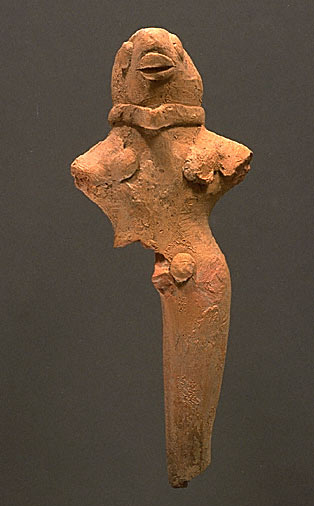
|
|
|
|
| |
|
Standing male figurine from Harappa
Other male figurines stand with their hands on their hips and their legs pressed together, a common posture for female figurines.
Approximate dimensions (W x H x D): 4.0 x 9.7 x 2.8 cm.
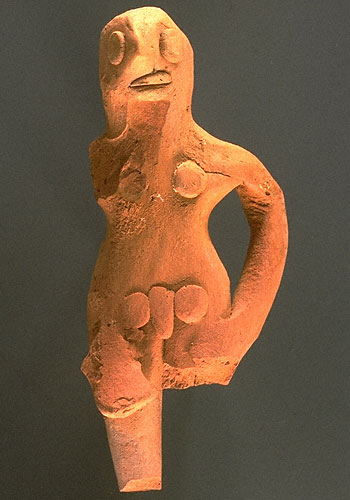
|
|
Male figurine with a fan-shaped headdress from Harappa
Most male figurines from Harappa do not wear headdresses. An unusual exception is a standing male figurine wearing a fan-shaped headdress usually worn by female figurines as well as a choker with pendants. This may be a representation of an alternative gender.
Approximate dimensions (W x H x D): 5.0 x 13.2 x 3.0 cm.
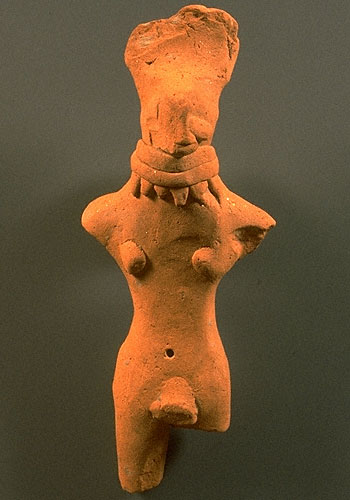
|
|
|
|
| |
|
Male figurine from Harappa
A few male figurines demonstrate unusual postures such as one with one leg extended forward and the other extended behind. Male figurines also sometimes wear a simple headband around the top of the head.
Approximate dimensions (W x H x D): 4.3 x 7.2 x 3.2 cm.
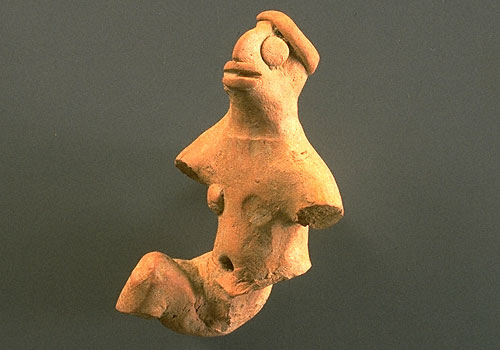
|
|
|
| |
|
Seated male figurine from Harappa
Seated male figurines may have their knees drawn up tightly to their chests. While some have facial features and headbands and/or hair, many have featureless faces and no ornamentation.
Approximate dimensions (W x H x D): 3.6 x 4.9 x 3.0 cm.

|
|
Male figurine with hair swept forward from Harappa
In addition to different postures, male figurines also exhibit a variety of hairstyles. Both male and female figurines may have hair swept around the top of the head, to the side or to the front. A few male figurines also wear a sort of "torque" choker made of two strands with a slight pinched projection at the throat.
Approximate dimensions (W x H x D): 4.8 x 7.1 x 2.2cm.
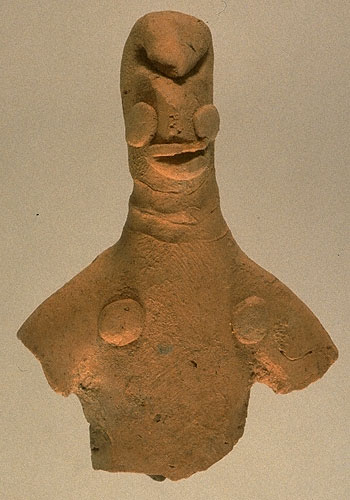
|
|
|
|
| |
|
Seated male figurine with hands raised from Harappa
Another type of male figurine sits with legs extended straight in front of the body and arms raised in front of the chest with hands clasped together, probably a posture of devotion or prayer.
Approximate dimensions (W x H x D): 2.9 x 5.1 x 5.8 cm.

|
|
|
| |
|
Seated Male Sculpture
Seated male figure with head missing. On the back of the figure, the hair style can be partially reconstructed by a wide swath of hair and a braided lock of hair or ribbon hanging along the right side of the back.
A cloak is draped over the edge of the left shoulder and covers the folded legs and lower body, leaving the right shoulder and chest bare. The left arm is clasping the left knee and the hand is visible peeking out from underneath the cloak. The right hand is resting on the right knee which is folded beneath the body.
Material: limestone
Dimensions: 28 cm height, 22 cm width
Mohenjo-daro, L 950
Islamabad Museum
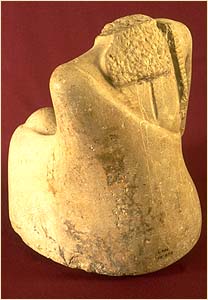 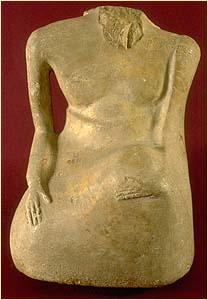
|
|
Various Citizens
These three standing figurines attract attention due to their different styles and attitudes. The female figurine on the left has a long neck and many necklaces. A nude male figurine in the center seems to wear an expression of quiet calm, while the male figurine on the right exudes an almost regal dignity. Variety of representation helps us imagine the rich variety of people that were living in the cities and villages of the Indus Civilization.
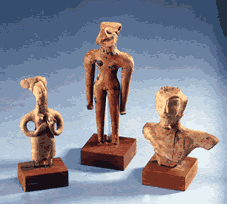
|
|
|
|
| |
|
Figurine Heads
A collection of male figurine heads showing different types of headdresses and beards from recent excavations at Harappa

|
|
|
| |
|
Four male figurines with horned headdresses from Harappa
Male figurines are sometimes also identified by secondary sex characteristics such as beards. Occasionally, male figurines wear a headdress with two upward and/or outward projections like horns. Similar figures with horned headdresses are found in the iconography of seals, tablets, and pottery. It is possible that these represent composite figures with anthropomorphic and animal attributes or the appropriation of animal attributes in the form of a headdress.
Approximate dimensions (W x H x D) of the largest figurine: 2.9 x 8.0 x 2.6 cm.
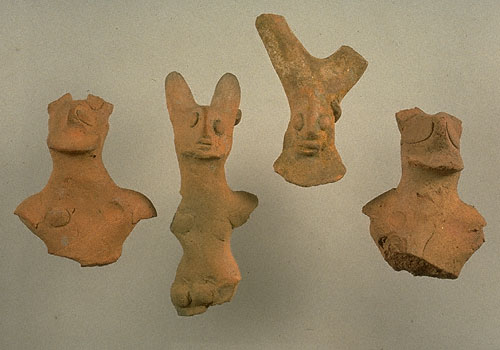
|
|
|
| |
|
Two seated male figurines from Harappa
Most male figurines from Harappa sit with knees bent and arms at the sides of the legs or around the knees. Some of these figurines have facial features and even genitalia, and a few have stylized legs joined into a single projection.
Approximate dimensions (W x H x D): 4.6 x 6.3 x 4.4 cm. and 3.2 x 4.6 x 4.9 cm.

|
|
|
| |
|
Male Figurine
Three seated male figurines from Harappa
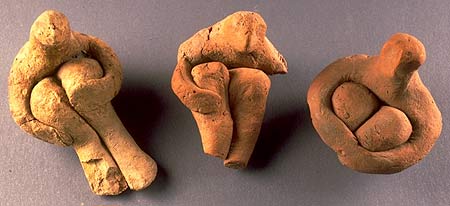
|
|
|
| |
|
Three male figurines from Harappa
Male figurines may be distinguished by genitalia and/or small flat nipples. A few male figurines wear chokers with pendants very similar to those worn by females. Some males are depicted with bowed legs.
Approximate dimensions (W x H x D) of the largest figurine: 5.3 x 9.0 x 1.5 cm.
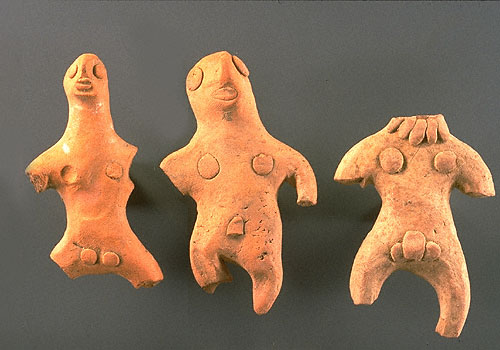
|
|
|
| |
|
| |
|
| |
|